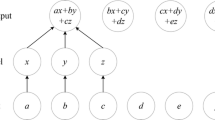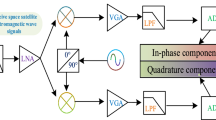Abstract
Wireless electromagnetic transmission using layered annulus space made up of tubing, casing and packer in production wells is an effective means of overcoming the corrosion, fracture, winding and sealing problems of current cable transmission. Tubing, casing and packer are all good conductors for electromagnetic transmission. So, the high-frequency signal attenuates very fast with transmission due to the skin effect, only the super-low frequency (30 Hz–300 Hz) band can be selected. The feature difference between frequency 0 and frequency 1 of BFSK modulation signal in super-low frequency segment is very small, and the bandwidth is very narrow too. In addition to low signal-to-noise ratio and channel interference under the conduction of production wells, the frequency characteristics of 0-frequency and 1-frequency signals become fuzzier. The traditional BFSK demodulation method based on broadband is difficult to demodulate the ultra-low frequency signal. As the strong pattern recognition ability of deep learning neural network, a method of demodulating BFSK signal in ultra-low frequency band based on deep learning is proposed. The convolutional neural network is used to design the demodulation model from the modulation signal of super-low frequency segment to the corresponding binary signal. The network model inputs the super-low frequency modulation signal sequence with the size of 20 * 20 and outputs the demodulation signal with the size of 4 * 1. Firstly, 3200 super-low frequency BFSK modulated signals and corresponding original binary signals were obtained through MATLAB simulation, in which the carrier frequency of modulation signal element 1 was 100 Hz and the carrier frequency of code element 0 was 200 Hz. The sampling points of each code element in the signal are 100, and the transmission time of 4 code elements is 0.08 s. Then the modulated signal is added with Gaussian white noise to simulate channel interference, among which 2560 signals are used as training data to train the network model, and the other 640 signals are used as test data. The simulation test results show that our method has a stronger anti-interference ability of ultra-low frequency modulation signal than the traditional demodulation method. The next step is to apply the network model to real data to further verify the generalization and practicality of the method.
Access this chapter
Tax calculation will be finalised at checkout
Purchases are for personal use only
Similar content being viewed by others
References
Wu, T.: CNN and RNN-based deep learning methods for digital signal demodulation. In: Proceedings of the 2019 International Conference on Image, Video and Signal Processing - IVSP 2019 (2019)
Li, M., Zhong, H.S.: Neural network demodulator for frequency shift keying. In: International Conference on Computer Science & Software Engineering. IEEE (2008)
Wang, X., Wang, J., Dang, Z., Huang, W.: A deep learning-based MSK signal demodulation method under mixed noise. CN110233810A, 2019-09-13
Meng, F., Lenan, W.: Demodulator based on deep belief networks in communication system. In: 2017 International Conference on Communication, Control, Computing and Electronics Engineering (ICCCCEE) (2017)
Mohammad, A.S., Reddy, N., James, F., Beard, C.: Demodulation of faded wireless signals using deep convolutional neural networks. In: 2018 IEEE 8th Annual Computing and Communication Workshop and Conference (CCWC) (2018)
Ouyang, X.: MPPSK signal demodulator based on convolutional neural network.Southeast University (2016)
Liang, F., Shen, C., Wu, F.: An iterative BP-CNN architecture for channel decoding. IEEE J. Sel. Top. Signal Process. 1–1
Huang, Y., Zhang, J., Zhou, X., et al.: Signal demodulation using deep learning. Telecommun. Technol. 07, 5–8 (2017)
Lohit, S., Kulkarni, K., Kerviche, R., Turaga, P., Ashok, A.: Convolutional neural networks for noniterative reconstruction of compressively sensed images. IEEE Trans. Comput. Imaging 4(3), 326–340 (2018)
West, N.E., O’Shea, T.: Deep architectures for modulation recognition. In: 2017 IEEE International Symposium on Dynamic Spectrum Access Networks (DySPAN), pp. 1–6. IEEE (2017)
Acknowledgments
The project is supported by High-tech project of Sichuan Provincial Science and Technology Department (2020YFG0182), Sichuan Provincial Work Safety Supervision and Administration Project on Safe Production Technology (sichuan-0004-2016AQ), Science and Technology Project of China Petroleum Exploration and Development Research Institute (RIPED.CN-2019-CL-53).
Author information
Authors and Affiliations
Corresponding author
Editor information
Editors and Affiliations
Rights and permissions
Copyright information
© 2021 The Author(s), under exclusive license to Springer Nature Singapore Pte Ltd.
About this paper
Cite this paper
Lin, L., Li, Wq., Peng, M., Tan, Hf. (2021). Demodulation of BFSK Signal for Super-Low Frequency Wireless Communication Based on Deep Learning. In: Lin, J. (eds) Proceedings of the International Petroleum and Petrochemical Technology Conference 2020. IPPTC 2020. Springer, Singapore. https://doi.org/10.1007/978-981-16-1123-0_45
Download citation
DOI: https://doi.org/10.1007/978-981-16-1123-0_45
Published:
Publisher Name: Springer, Singapore
Print ISBN: 978-981-16-1122-3
Online ISBN: 978-981-16-1123-0
eBook Packages: EnergyEnergy (R0)




